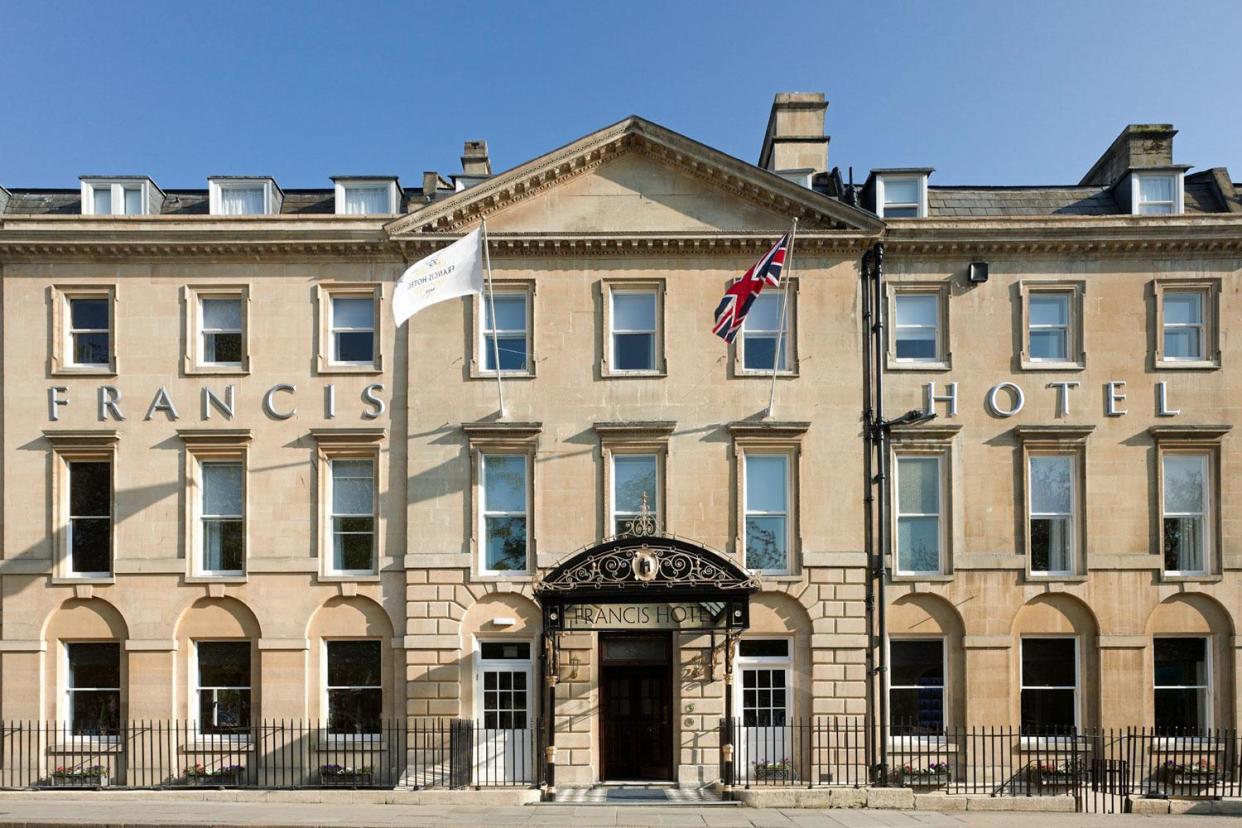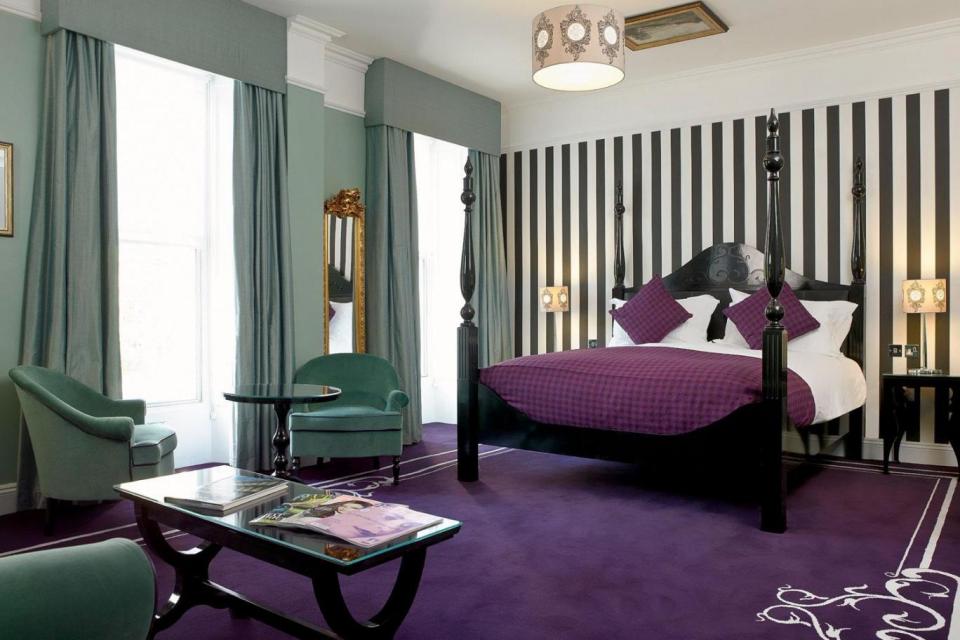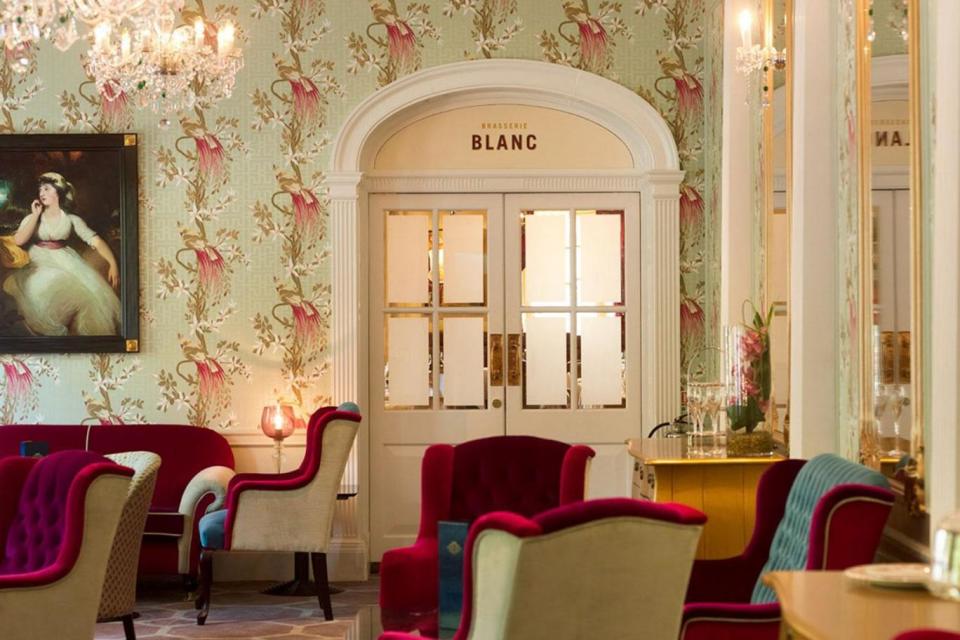Francis Hotel Bath – MGallery by Sofitel - hotel review

You’ve been to Bath? No? Seriously? You must, you just must.
This is quite possibly the loveliest little city in England. It’s quite extraordinary in terms of its architectural completeness and miraculous unspoiledness; it’s a Roman spa town which became a cathedral city which became a spa town all over again in Jane Austen’s time – and yes, she’s the presiding genius of the place – and has the loveliest Georgian architecture you’ve ever seen – the Royal Crescent is as beautiful as it’s cracked up to be.
The whole thing is a miracle of harmonious honey coloured stone; one lovely square after another. It’s also a university town, though it wasn’t built as one. And it’s extraordinarily compact, with nowhere, apparently, more than a 20 minute walk from the centre of town.
Where is it
And about ten minutes’ walk from the cathedral, you get the Francis Hotel, in Queen’s Square, one of the prettiest garden squares in the city. The hotel is made from a row of seven town houses built in the early eighteenth century on the southern end of the square, overlooking a garden where, when we were there, a bowling green had been set up. Three of the houses had been destroyed in the war, but the outlines of each of them is evident in the layout of the hotel.

Style
The hotel is on the site of seven Georgian townhouses, and the sites of each of the houses is marked on the upper floors, and a plaque commemorating the former inhabitants. If only the place were haunted it would have some choice ghosts from the former residents. The wallpaper, for instance, changes from one house to another. Interestingly, these houses would have been rather narrow; their dimensions domestic… very Jane Austen.
The hotel justifiably makes a thing of its Georgian heritage; there are portraits from the period in the downstairs drawing room and there’s a conscious effort to capture an Austenesque feel in the little bar area set aside for afternoon tea and drinks. Upstairs the wallpaper shows Georgian silhouettes or drawings of Georgian buildings - though given that you’re actually in one, you hardly need reminding. There are whimsical pictures throughout of Georgian social scenes; and above the beds, there’s a picture on the ceiling of the local architecture, so you can take it in while you’re lying down. The bedroom is in calming colours – pale sage in our case - with gilt mirrors.
The reception area is small, the drawing room spacious and the dining room – a branch of Brasserie Blanc – big, with the window tables giving a lovely view of the square. The place is relaxed rather than grand or formal.
Facilities
The lobby opens up into a lounge area. There’s a little ground floor bar, where you can also have afternoon tea. There are no spas or pools in the hotel, but hey, this is Bath; you have your thermal spa in town; the point of this place is not just to be a destination in itself but a launch pad for the city. And from that point of view it can hardly be bettered.
The bathrooms are small, with striking black and white stripes. On the crucial question of toiletries, you’re sorted; it’s the White Company. There’s a Nespresso machine in every room, and - I think as a gesture to female guests, a particular concern of this chain - there’s a chamomile tea bag put out in your cup and saucer by the bed at night and a kettle for making your own tea. The great thing is to buy some Bath buns in the shop down the street – you cannot come to Bath and not have a bun - and bring them back for tea in your room.

Which room?
There are 98 rooms, in three categories; they’re individually designed with whimsical takes on Georgian prints; some have four posters. Several have views onto Queen Square and for families, you can have interconnected adjoining rooms.
Food and drink
A buffet breakfast is served daily in a separate dining room, with all the elements of an English breakfast and the usual continental elements: fruit, cheese, ham, yoghurt, cereals and croissants. There’s also an a la carte breakfast menu. You can have afternoon tea off the lobby, with sandwiches and cake; Bath, need I say, is an afternoon tea sort of place.
The hotel restaurant is one of Raymond Blanc’s brassieries, and as you’d expect, the menu is French, but with some international elements. If confit of duck with cherries, beef burgundy, slow cooked pork and minute steak with frites is your thing – and they are mine – you’re sorted. The service at dinner is diligent and friendly; at breakfast, more laid back.

Extracurricular
The hotel couldn’t be handier as a base for exploring the city; as I say, nowhere seems more than a 20 minute walk away. The miracle of Bath is that, for all the actors in period dress about, it stops this side of twee; it’s simply extraordinarily well preserved. Up the hill, there’s the splendid sweep of the Royal Crescent, with its lovely park, or there are the impressive Assembly Rooms – did I mention that Jane Austen is the guiding deity of this place? – which are utterly evocative, with a museum of fashion below.
Down from Queen Square there are the two must-sees, the Roman baths and the Abbey. The Baths are extraordinary and although there’s plenty of interpretative material, it doesn’t take away from the still-impressive structure – part of the bath complex is an actual swimming pool. The funniest bit is the exhibits of curse tablets, once thrown into the water, in which disgruntled patrons invoked the wrath of the goddess on the chancers who stole their clothes while they were bathing: some things, you feel, just don’t change.
Next to the baths proper are the Pump Rooms, where you could and still can take the healing waters, though you can also drink it for free in the baths themselves: a sip is enough for most people. The elegant Pump Rooms are a must for the best afternoon tea, with a pianist playing, though it opens from breakfast through to evenings (in summer).
The abbey is lovely – the last Catholic bishop just saw the building through to completion right before the Reformation, which was really rubbish timing. The best bit of it is the façade, with angels busily going up and down ladders between earth and heaven; inside there are some fabulous, poignant eighteenth century epitaphs. You can attend services for free.
One treat is the charming Sally Lunn tea rooms, where the once-famous Sally Lunn tea cakes were made – an enormous sort of English brioche. You can still eat them there now, in savoury form as well as with jam or lemon curd.
As for taking the waters, this is one of the few places in England where you really have a proper spa; at the Thermal Spa you can bathe in the healing waters, rather like the Romans did, except with proper drainage and treatment packages.
But honestly, there’s just so much to see here, like the eighteenth century Pultenay bridge with shops built into it, leading eventually to the Holburn museum, with its collection of Georgian and Victorian silver and art. Or there’s the Victoria gallery, which has a small but charming art collection, including – drum roll – a bust of the inventor of Plasticine.
Where to buy your Bath bun? I hear you ask. I’d say at Richard Bertinet’s excellent bakery in New Bond Street Place, conveniently situated for the Francis hotel.
Best for
Bath buffs who want an excellent base for exploring this extraordinary city and who relish being in one of its prettiest Georgian squares. And just in case I didn’t make it clear by now, Bath is fabulous. How, in God’s name, have I never made it there until now?
Details
The Francis Hotel, Queen Square, Bath; enquiries@francishotel.com; bookings: www.sofitel.com
Classic rooms from £129 a night; superior rooms from £164 a night; feature rooms from £194 a night.
Head here for more hotel reviews.

 Yahoo News
Yahoo News 
